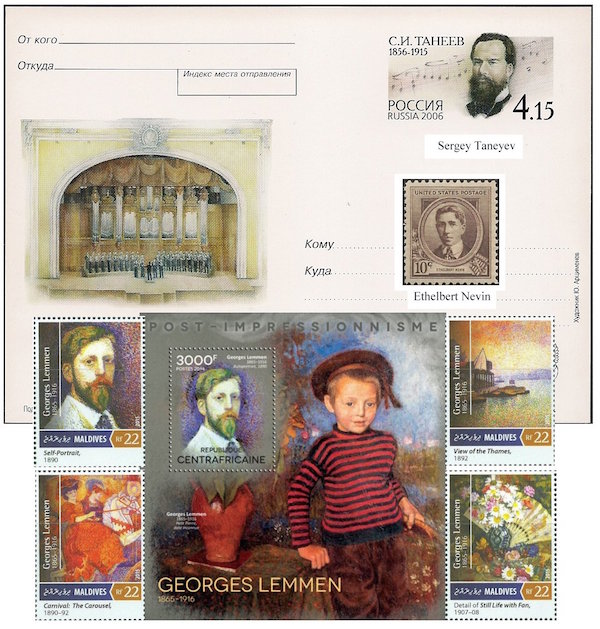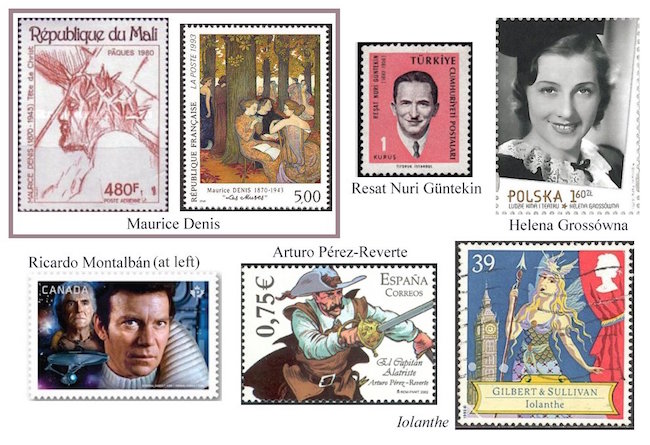The Arts on Stamps of the World — November 25
An Arts Fuse regular feature: the arts on stamps of the world.

By Doug Briscoe
Today is the birthday of perhaps the most prolific writer in history, Lope de Vega. Félix Lope de Vega y Carpio (1562 – 27 August 1635) is known to have written about 500 plays and 3,000 sonnets, besides three novels, four novellas, and nine epic poems. At least eighty of the plays are regarded as masterpieces. He wrote the libretto for what is held to be the very first zarzuela, La selva sin amor (The Lovelorn Forest), which was performed at the court of Philip IV on 18 December 1627. The music, now lost, was composed by Filippo Piccinini and Bernardo Monanni. Individual verses by Lope de Vega have been set as songs by a variety of Spanish and German composers, among them Turina and Joaquin Nin, Brahms (the “Geistliches Wiegenlied” with viola, Op. 91 no. 2) and Hugo Wolf (two songs found in the Spanisches Liederbuch).
We also salute the Austrian primary school teacher and church organist Franz Gruber (25 November 1787 – 7 June 1863), who on Christmas Eve in 1818 wrote the music to “Silent Night”. The original German lyrics (Stille Nacht) had been written two years earlier by priest Joseph Mohr (1792-1848).

By acknowledging German inventor and engineer Karl Benz (November 25, 1844 – April 4, 1929) we get to show some pretty stamps of classic automobiles. The 1885 Benz is considered to be the first practical motorcar. Benz merged with Mercedes (as Daimler-Benz) in 1926.
There is no stamp for Russian composer Sergey Taneyev, but he does have this postal card. Taneyev (born O.S. November 13, 1856) entered the Moscow Conservatory at the age of nine and wound up in Tchaikovsky’s composition class. On his graduation in 1875, he was the first student in the history of the school to win the gold medal both for composition and for performance (piano). He was also the first of only three students to be awarded the Conservatory’s Great Gold Medal; one of the other two was Rachmaninov. That same year he gave the Moscow première of Tchaikovsky’s First Piano Concerto and so impressed the older composer that Taneyev was subsequently asked to be soloist in the Russian première of the Second Piano Concerto and the first public performance of the Piano Trio. Tchaikovsky’s symphonic fantasy Francesca da Rimini is dedicated to Taneyev. It was Taneyev who made a performing version of Tchaikovsky’s unfinished Third Concerto. But we anticipate a bit. Taneyev toured Russia with Leopold Auer in 1876. He himself taught at and was director of the Moscow Conservatory from 1878 to 1889. Among his pupils there and independently were Rachmaninov, Scriabin, Glière, and Medtner. He was the guest of Tolstoy during the summers of 1895 and 1896, and the novelist’s wife Sofia became infatuated with him; this situation served as the inspiration for Tolstoy’s great story “The Kreutzer Sonata”. It is ironic that Taneyev contracted pneumonia while attending the funeral of Scriabin, who had largely abandoned Taneyev’s compositional methods. It was while recovering that Taneyev died of a heart attack on June 19 (O.S. June 6), 1915.

Ethelbert Nevin (November 25, 1862 – February 17, 1901) was born in Edgeworth, Pennsylvania. His father, Robert Peebles Nevin, was editor and owner of a Pittsburgh newspaper and a writer who also composed several campaign songs, one of which, “Our Nominee”, was used during James Polk’s candidacy. Wikipedia tells us that “the first grand piano ever taken across the Allegheny Mountains was carted over for Nevin’s mother”, Elizabeth Duncan Oliphant. Young Nevin studied in Boston and Berlin, where one of his teachers was Hans von Bülow. Nevin lived a rather nomadic existence, taking up residence in Boston (again), Paris, where he taught singing, Berlin again, Algiers, Florence, Venice, and again Paris before his final return to the US. His output seems to be limited exclusively to piano pieces and songs, along with some twenty choruses. Dogged by debt, depression, and alcoholism, Nevin died in New Haven, Connecticut, two days after attending a recital given by Harold Bauer.
The neo-impressionist painter Belgian Georges Lemmen (1865 – 5 June or 5 July 1916) was influenced by Degas, Toulouse-Lautrec, and Théo van Rysselberghe. (Toulouse-Lautrec’s birthday was yesterday and van Rysselberghe’s the day before.) Lemmen became a member of the group Les XX in 1888, five years after its founding. Four stamps from a Maldivian sheet surround a complete minisheet from the Central African Republic. The 1890 Self-Portrait features on both. (I found another interesting self-portrait online.). The remaining Maldivian stamps show Carnival: The Carousel (1890-92), View of the Thames (1892), and a detail from Still Life with Fan (1907-08), while the large image on the CAR sheetlet is of Little Pierre (undated). Another striking picture, one showing his use of pointillism, is The Serruys Sisters (1894).
A painter of the same generation was Maurice Denis (25 November 1870 – 13 November 1943), born on the coast of Normandy, who from childhood was passionate about religion and art. This is not to say that religion was his only subject as a painter—one of the two stamps, to be sure, shows a drawn head of Christ, but the other is a quite secular genre piece called The Muses. Another lovely piece I found online is his Game of Shuttlecock (1900). On the religious side, Denis strove to reinvigorate Christian art by founding, after World War I, the Ateliers d’Art Sacré (Workshops of Sacred Art). Earlier Denis was influenced by pre-Tahitian Gauguin and Japanese art. He met his muse, Marthe Meurier, in 1890 and put her into many of his canvases and decorative pieces. For example, she figures prominently in his lithograph for the cover of the sheet music for Debussy’s La Demoiselle Elue. Denis and Meurier were married in 1893. Later in the decade Denis embarked on a series of paintings inspired by Greek mythology but placed in contemporary settings, such as Bacchus and Ariadne and Polyphemus (both 1907). The latter work seems to have taken the figure of the cyclops from Poussin, whose version we saw here earlier this week. Clearly the more Puritanical side of Christianity was not what Denis had in mind. Moreover, after the death of Meurier in 1919, Denis remarried.
We have next a Turkish novelist and dramatist whose works have frequently dealt with social issues facing the people of the Anatolian plain. Resat Nuri Güntekin (25 November 1889 – 7 December 1956) worked as a teacher (literature, French, philosophy) and school administrator and served in a number of government posts, including at the Ministry of National Education, as a cultural attaché to Paris, and as a representative to UNESCO. The best known of his eighteen novels is Çalikusu (The Wren, 1922), which tells the story of a young woman teaching in Anatolia. There are also a dozen plays.

Polish actress Helena Grossówna (1904 – 1 July 1994) studied ballet as a girl in her native city of Toruń (at the time Thorn in Prussia). She made her stage debut in 1926 and studied and performed in Italy and France. She appeared for the first time in film in 1935 and took part in another fifteen films before World War II broke out, only returning to the screen in 1960, four years prior to her retirement. During the war she worked as a waitress but was also a lieutenant in the underground Polish National Army and commanded a women’s unit during the Warsaw Uprising. Captured by the Germans, she was interned in a POW camp. After the war she returned to Poland and worked with the Syrena Theater in Warsaw from 1948.
An actor more familiar to AoSotW readers will be Ricardo Montalbán (November 25, 1920 – January 14, 2009). He was born in Mexico and came to the US (Los Angeles) with his brother in 1940. The next year he appeared in a number of mini-musicals that were made to be shown in film jukeboxes. A devout Catholic, he was married only once, to Georgiana Young, a sister of Loretta Young, in 1944. Montalbán’s first leading role was in Border Incident, a 1949 film noir. In that year he became the first Hispanic actor to be on the cover of Life magazine. Although he mostly lived his life in the United States, he never became a citizen. Now if you haven’t gone ahead and peeked, you’ll be wondering how Ricardo Montalbán ended up on a stamp, and one from Canada, for that matter. Well, it’s for his role as Khan Noonien Singh in Star Trek II: The Wrath of Khan (1982), a part he had created on the original Star Trek TV series in 1967. You can see him menacing “Admiral Kirk” above the Enterprise on this Canadian issue from earlier this year.
Our last birthday personage today is the Spanish novelist Arturo Pérez-Reverte (born 25 November 1951), celebrated for his series of historical novels featuring the character Captain Alatriste, who first appeared in 1996 and has swashbuckled his way through a half dozen more novels since. Pérez-Reverte was also a journalist, working as a war correspondent for 21 years, from 1973 to 1994. His first novel, El húsar, set during the Napoleonic Wars, came out in 1986.
On this date in 1882 Gilbert and Sullivan’s Iolanthe premièred at the Savoy Theatre in London.
Deserving of a word (and a stamp, in my opinion) is the superb American science fiction writer Poul Anderson (November 25, 1926 – July 31, 2001).
A graduate of the University of Massachusetts with a B.A. in English, Doug Briscoe worked in Boston classical music radio, at WCRB, WGBH, and WBUR, for about 25 years, beginning in 1977. He has the curious distinction of having succeeded Robert J. Lurtsema twice, first as host of WGBH’s weekday morning classical music program in 1993, then as host of the weekend program when Robert J.’s health failed in 2000. Doug also wrote liner notes for several of the late Gunther Schuller’s GM Recordings releases as well as program notes for the Boston Classical Orchestra. For the past few years he’s been posting a Facebook “blog” of classical music on stamps of the world, which has now been expanded to encompass all the arts for The Arts Fuse.
